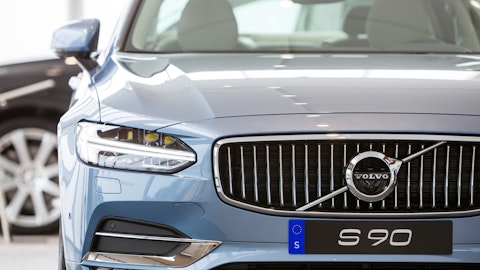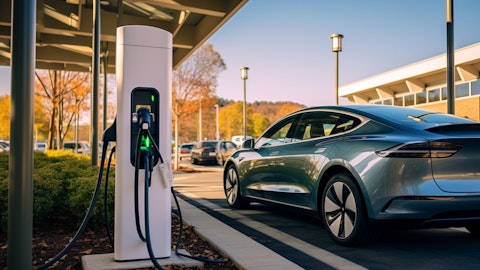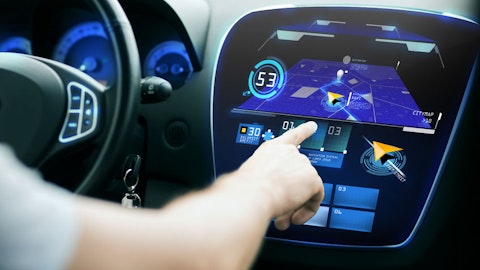RJ Scaringe: Yes. As you know, we’ve – and we’ve talked about this in the past, in past earnings calls, we are building a service footprint that relies on both physical brick-and-mortar service locations, we’ll have about 50 of those in the U.S. by the end of this year. But supplementing that and actually performing a majority of our service are mobile service vehicles. And our mobile service vehicle fleet, as I said, at the start is more than 400 vehicles, today, it’s – as of, I think, this week, it’s 408, but it continues to grow. And that the beauty of mobile service-first strategy is from a customer point of view, it’s a much easier process. So if there’s an issue on the vehicle rather than you as the customer having to deal with the vehicle being dropped off or taken to a service center, we simply come to you, we come to your house, we come to your place of business, and perform the service on site.
And more than half – well over half of all of our service operations there, mobile, we expect that to shift into greater than three quarters of all service operations will be performed with mobile service. Now that doesn’t completely relieve the need for physical infrastructure. The physical infrastructure is important for more significant service activities. And as I said, that’s why we continue to grow and invest in that network, and we’ll see that growing where – since we put service locations closest to where we have large pools or large pockets of demand.
Operator: Thank you. Our next question comes from the line of Joseph Spak with UBS. Your line is now open.
Joseph Spak: Thanks so much everyone. Claire, I know you sort of talked a little bit about some of the puts and takes into next year. But you’re right now running at a $65,000 run rate this quarter. So in the context of the downtime and the 150,000 total capacity, how should we be thinking about next year’s potential? Is that sort of 65 run rate about the right level you guys are planning for next year?
Claire McDonough: So as you mentioned, there’s going to be a number of puts and takes overall. And it’s important to note that the impacts of the shutdown are temporary in nature, but the benefits will be there for the future, and RJ spoke briefly to – just the magnitude of technology changes that will be introduced into the R1 vehicles next year that creates a true step change in our material cost road map, and past deposit gross profit margin for us as a whole. So as you think about the cadence of the year, as I mentioned in my prepared remarks, right, we’ll start Q1, akin to our current and existing run rate. And then Q2 and Q3 will be heavily impacted quarters from a production standpoint, where we’ll take multiple weeks of downtime throughout the course of Q2.
And then we’ll be ramping up all of the respective variance of R1, both in Q2 and into Q3 as well. And then as we’ve talked about in the past, Q4 becomes that run rate potential for the business where you’ll see Rivian continuing to ramp up our volumes from a production standpoint for both R1, as well as our commercial volumes. You’ll see the full impacts of each of the new technologies, hitting our material costs, that also coincides with a significant percentage of the commercial cost down opportunity that we have in front of us as well. And so those elements come together in connection as well with Rivian fulfilling our pre-3/1/2022 preorders, which also results in a step change in our average selling price of the vehicle over that period of time as well.
So next year is certainly a year of different puts and takes, but that’s directionally how I would think about the volume cadence.
Joseph Spak: Okay. That’s helpful. And actually, that danced nicely into my next question. RJ or Claire, I mean, you’ve talked about this in the past about the higher ASPs with the backlog. And RJ, you sort of mentioned some of the affordability concerns out there in EVs, but really, I’d say, in broader auto as well, at least in the headlines. So clearly, you have good visibility on your backlog through 2024. But how are you thinking about or planning for the margin profile for the business once you get past that, like if affordability is a greater concern, do you have enough line of sight on cost reduction initiatives or other efforts to sort of help balance out what might be a little bit of a tougher pricing environment?
RJ Scaringe: Yes, we’ve talked about this a bit in the past, but when we think about the R1 platform, we launched with Quad-Motor Large Pack, that’s our middle-sized pack and one trim configuration. And what we’ve done over the last few months as we start to introduce additional build combinations above and beyond that. So we introduced the Dual-Motor, that’s built around our Enduro Motor platform. We, of course, introduced our Max Pack, which is our largest battery pack. Next year, we’ll be introducing our standard pack, which is our smallest battery pack, and we’ll be introducing a variety of different trim and build combinations along with that over the course of the next year. And what that does is it provides us with a broader spread of prices or price choices for consumers on the R1 platform to essentially be able to target both the most price-sensitive customers, as well as customers are looking to buy sort of the fully loaded maximum content vehicle.
And what that effectively does is it allows us to benefit from the higher margin profile on these higher price, full content vehicles and balance it with the lower priced, lower content vehicles and still look at it as we look at that in the lens of ASP, still see ASP grow over time. And a big contributor to that, which Claire alluded to is, as we start to blend in newer pricing and we move past the pre-March 1, 2022 pricing, that’s also going to have an accretive effect on overall ASP. The other thing to keep in mind from a demand point of view, is just the scale of the segments that we’re operating in. The three row SUV space and the pickup segment represent very large pools of demand. And of course, across those large pools of demand, there’s a range of prices, but this is a really important element for us, is just recognizing how much overall demand potential there is, and we’re seeing with increased awareness and excitement for the brand that translate to lots and lots of new EV customers.
The other thing which is worth just bringing up in the context of some of the negotiations that we’ve had with R1, is the bill of material cost reductions we’re seeing, and these are significant, and we’re going to see them quarter-over-quarter. I’ve described the performance like this staircase set of changes quarter-over-quarter, with a big step being that which comes in quarter two of next year. But we’ve been able to leverage suppliers excitement for R2 to achieve materially lower costs in our bill of materials that will start to layer in along with what comes in Q2, but even beyond that. And so R2 is sort of this incredible carrot for suppliers. And one of the things that’s become very clear, particularly in the last two to three quarters is just how well the Rivian brand is resonating, and suppliers are recognizing relative to some of the other customers, just how much volume we’re delivering and how much demand there is for our products, relative to a wide variety of established brands, and they recognize that, that excitement for our brand will also translate to lower price points.
And the R2 captures the essence of our brand, but of course, to a smaller package and in a much lower price point.
Operator: Thank you. Our next question comes from the line of Mark Delaney with Goldman Sachs. Your line is now open.
Mark Delaney: Yes. Good afternoon. Thanks for taking my question. You reiterated your view to be gross margin positive in 2024, but I’m hoping to better understand if you’re views in how Rivian will get there, have changed at all recently, given the volatility in the industry more broadly with competitors cutting EV vehicle prices, but also costs falling in Rivian, as you’ve described, making so much progress on its own cost structure.
RJ Scaringe: Thanks, Mark. I’ll let Claire jump in on this as well. This is just such an important topic. And ultimately, there’s – I just spoke to it a bit, but there’s a few major levers. The first being, the continued ramp-up of our production facility and the fixed cost absorption that comes with that. We’re seeing the benefits of that quarter-over-quarter as we continue to ramp. So it’s numerically very easy to understand. The second, which is maybe less – it’s not as easy to see without having a look into all of our supplier negotiations and discussions is the significant progress we’re making contractually with redefining build material costs or material costs through negotiations with suppliers, through resourcing of new suppliers, or through changes to the component or system design to achieve those cost reductions.





